Briefly: In our opinion, full (150% of the regular full position) speculative short positions in gold, silver and mining stocks are justified from the risk/reward perspective. This position was originally featured on Jan. 12, 2017 at 3:49PM.
The white metal showed no signs of weakness last week and we discussed the implications in the recent alerts. However, the long-term factors are usually (if not always) more important than the short-term ones, so in today’s alert we discuss the former.
Let’s – unsurprisingly – start with the long-term chart for silver (charts courtesy of http://stockcharts.com).
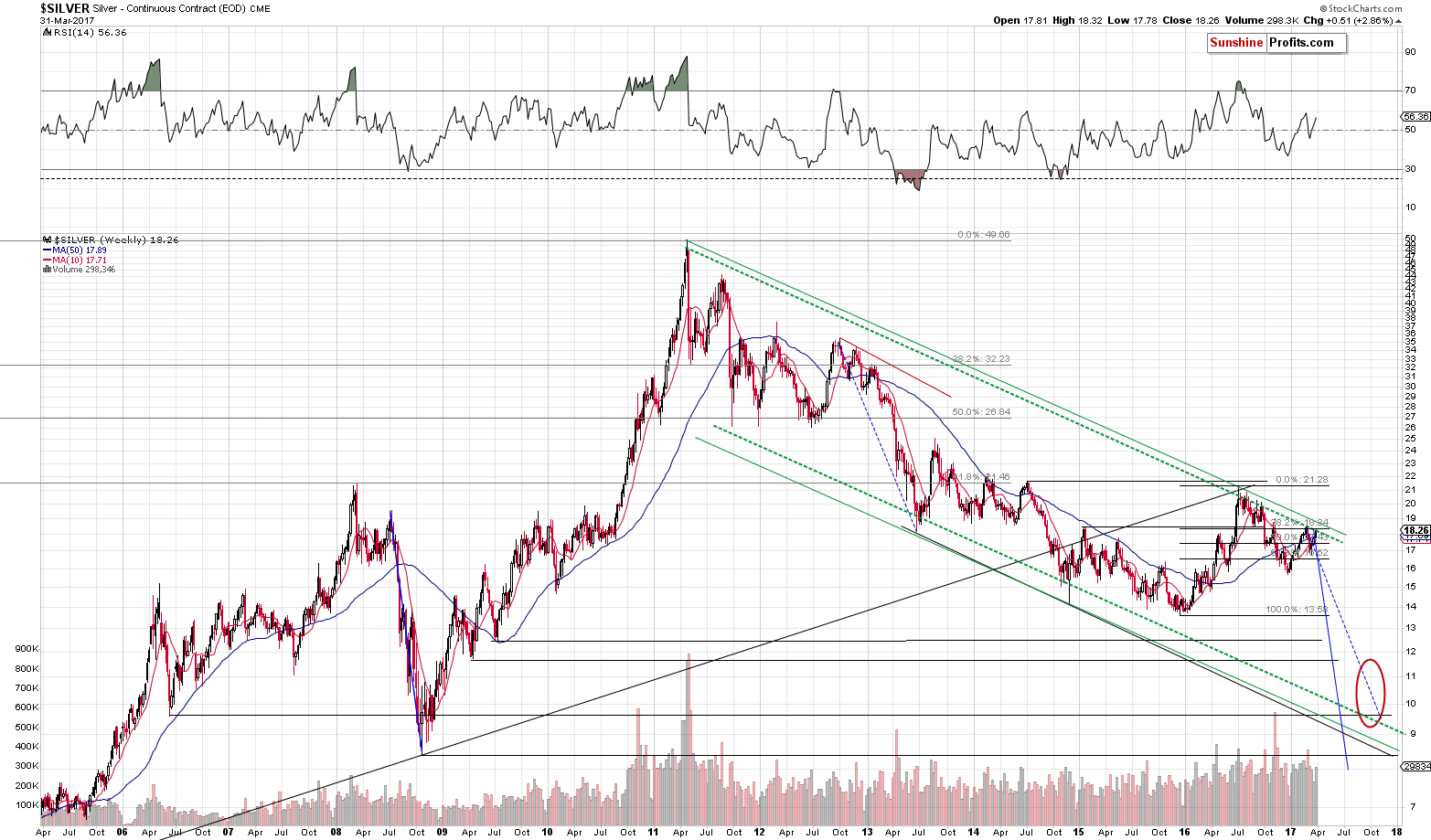
There are a few things that decide whether a resistance line is strong or not. The more important the tops that it’s based on, the more important the resistance line. The more tops create a given line, the more important the resistance is. Finally, for the line to be very important, the space between the tops that create it should be rather significant (for instance the red line based on 2 late-2012 tops didn’t result in anything in the following months and years).
Moreover, the way a given resistance line is likely to work is based on what created a given line. Therefore, a resistance line based on intra-day tops is likely to stop intra-day moves, a line based on daily closes is likely to stop the moves in terms of daily closing prices (so that the closing price doesn’t break the line even though intra-day moves might) and the line based on weekly closes is likely to stop the moves in terms of weekly closing prices (in analogy to daily closing prices).
After the rather lengthy introduction, let’s move to the point. Silver just moved to the line that is very important (green dashed line based on one extremely important top, one very important top and one less important top) and it did so in terms that were in tune with what the line was based on – silver closed the week at the line that was based on weekly closing prices.
The implications are naturally bearish for the following weeks and months as the above means that even if silver moves a bit higher temporarily, it’s unlikely to move higher substantially or for long. The above alone suggests that we are in the “pennies to the upside and dollars to the downside” territory without considering anything else (including the USD Index). The situation would be different if the silver had broken above this line and confirmed this breakout – but it didn’t, so the implications of moving to it are clearly bearish.
So, a reversal is very likely to occur shortly, if it didn’t occur on Friday. What else can we infer from silver’s long-term picture? The likely time-frame for a major reversal to the upside.
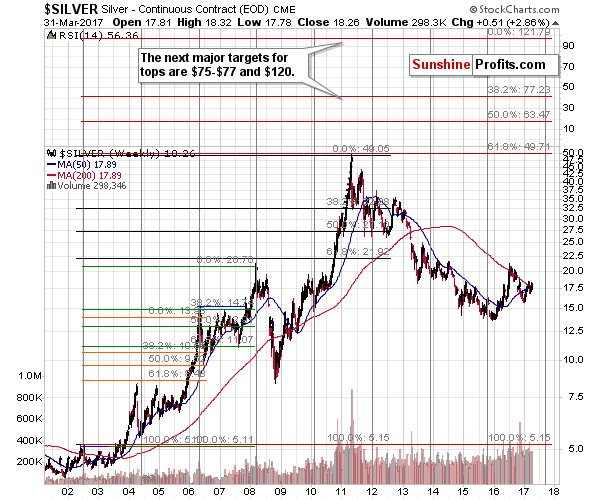
Silver’s very long-term cycles suggest a major reversal in the second half of this year and in light of the bearish case created by the previous chart (and other factors as well) it’s likely that it will be a reversal to the upside that will likely mark the end of the big decline that is probably starting. Please note that these turning points work on a near-to basis and due to the long-term nature of the chart, it is not the exact moment that the turning point suggests that is so important – it is the second half of the year in general. In other words, whenever – during the second half of 2017 – a major bottom in silver is formed, it will be quite likely that it will be the final bottom of the entire 2011 – 2017 decline.
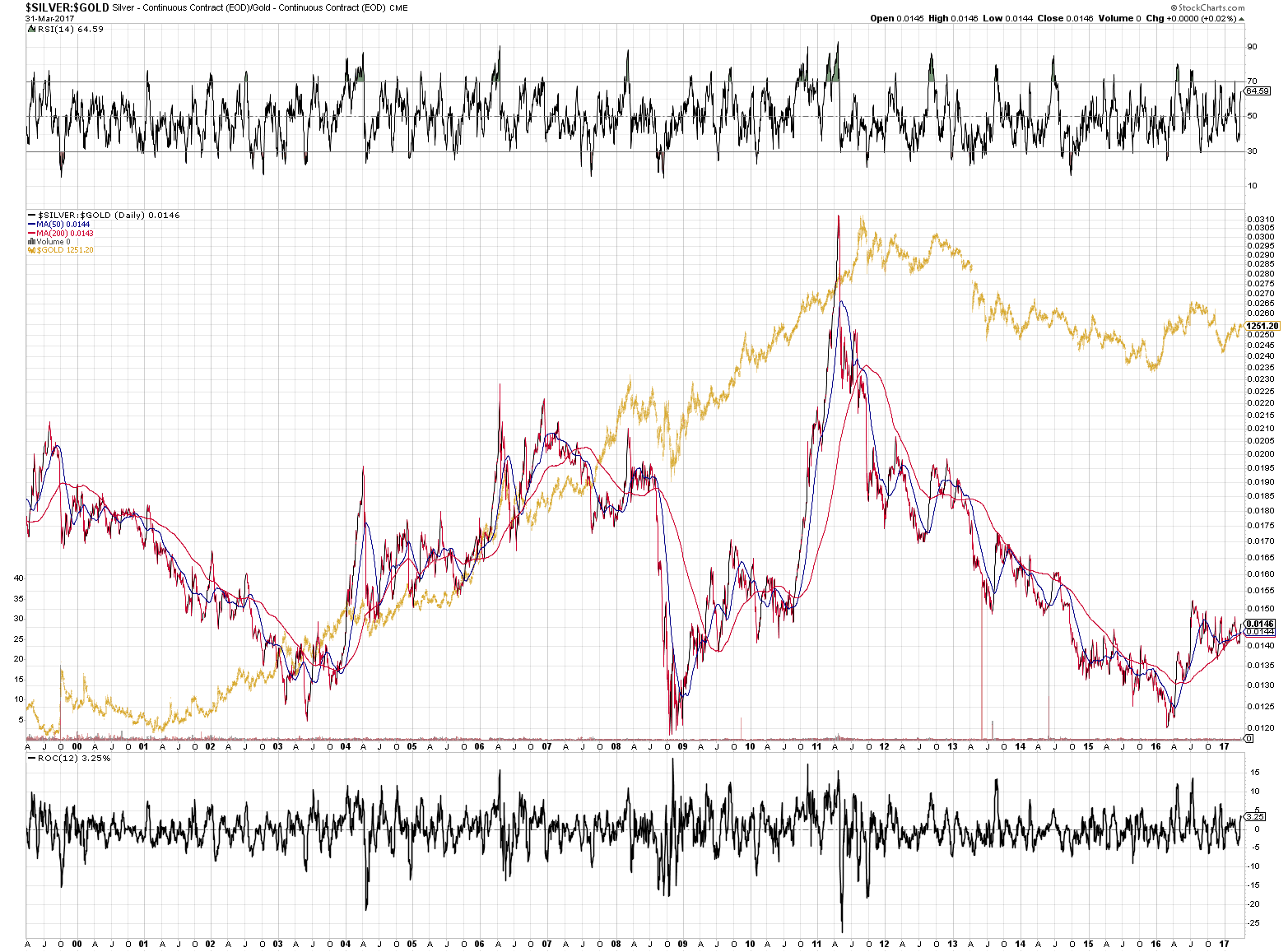
Silver’s lack of volatility and sharp underperformance is something that also makes one think that the final bottom in the precious metals sector has not yet been formed (neither in 2015 nor in 2016). Please take a look at the lower part of the above chart – it shows the Rate of Change indicator based on the silver to gold ratio. If silver’s value drops quickly relative to gold, this indicator will move sharply lower. Quite a lot of declines ended in the above way. The logic behind this phenomenon is the opposite of what silver does in the final days of the rally. Just as it outperforms at the end of the rally as more investors from the general investment public enter the silver market than the gold market (relative to professional investors), it underperforms at the end of the decline as proportionately more investors from the general investment public than professional investors exit the market at that time. Spikes in the ROC illustrate the above phenomenon (the 1999 bottom was confirmed in this way and the same goes for the 2008 bottom).
Now, we haven’t seen any meaningful spike lower in the ROC based on the silver-to-gold ratio in years, which suggests that the precious metals market is probably still in a huge corrective phase after the decade-long bull market. This indicator is one of the things that we will be looking for as a confirmation that the final bottom is indeed in or at hand. Again, we have yet to see it, so it’s likely that we have yet to see the final bottom as well.
Silver’s likely underperformance before the bottom along with gold’s target below $1,000 and likely close to $900 implies that the drop in the silver price is likely to be epic. Would silver at or close to $10 be scary or ridiculous enough for people to stop believing that there is any bottom for silver in sight or to shake out even the most hard-core investors out of their long positions? It appears to be the case and that’s exactly what is needed / expected at the real final bottom.
As far as the short-term picture is concerned, there’s little to say about silver except that it didn’t really move (back and forth movement only) and as far as gold’s and miners’ performance is concerned, we can say that on Friday they likely corrected after Thursday’s price moves.
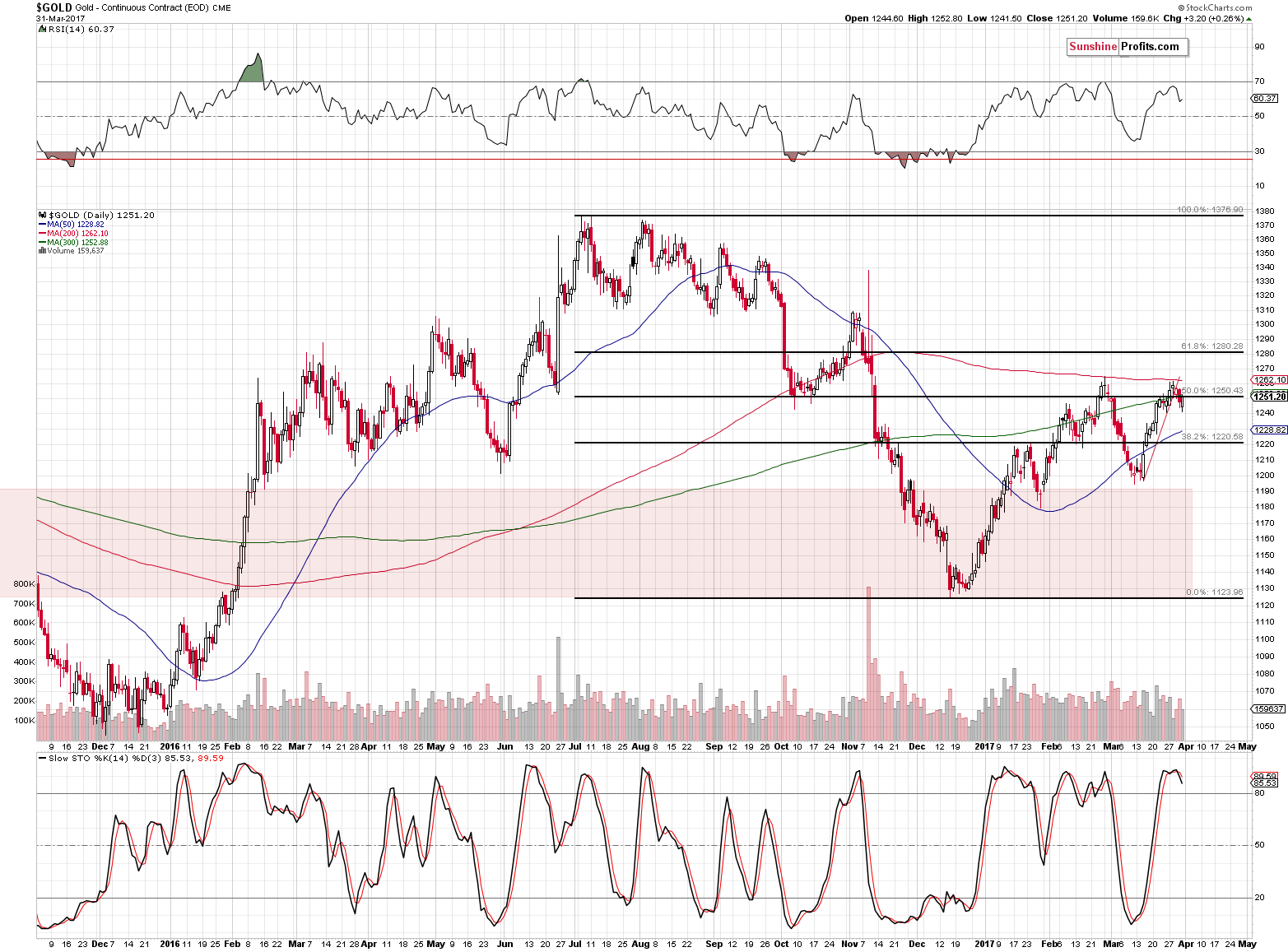
Gold moved a bit higher on relatively low volume, which was seen after a breakdown below the short-term rising support line. This is a classic post-breakdown correction without any bullish implications.
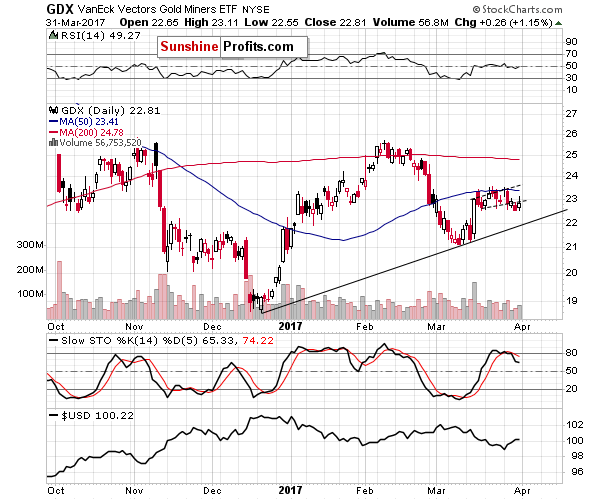
Mining stocks moved higher on volume that was a bit bigger than what we had seen previously, but the closing price was still below the very short-term support/resistance line (the lower border of the previous “flag” pattern which, most likely, turned out to be a triple top pattern). Moreover, the sell signal from the Stochastic indicator was not invalidated. The outlook remains bearish.
Summing up, the long-term silver charts suggest that we are about to see several months of lower silver prices and since it’s highly likely that the entire precious metals market will move together, this implies months of declines also in the case of gold and mining stocks. The long-term analogy to 2002 and 2003 in the USD Index remains in place and it fully supports the above the outlook.
As always, we will keep you – our subscribers – informed.
To summarize:
Trading capital (supplementary part of the portfolio; our opinion): Short positions (150% of the full position) in gold, silver and mining stocks are justified from the risk/reward perspective with the following stop-loss orders and initial target price levels / profit-take orders:
- Gold: exit-profit-take level: $1,063; stop-loss: $1,273; initial target price for the DGLD ETN: $81.88; stop-loss for the DGLD ETN $48.17
- Silver: initial target price: $13.12; stop-loss: $18.67; initial target price for the DSLV ETN: $46.18; stop-loss for the DSLV ETN $19.87
- Mining stocks (price levels for the GDX ETF): initial target price: $9.34; stop-loss: $26.34; initial target price for the DUST ETF: $143.56; stop-loss for the DUST ETF $21.37
In case one wants to bet on junior mining stocks' prices (we do not suggest doing so – we think senior mining stocks are more predictable in the case of short-term trades – if one wants to do it anyway, we provide the details), here are the stop-loss details and initial target prices:
- GDXJ ETF: initial target price: $14.13; stop-loss: $45.31
- JDST ETF: initial target price: $104.26; stop-loss: $10.78
Long-term capital (core part of the portfolio; our opinion): No positions (in other words: cash)
Insurance capital (core part of the portfolio; our opinion): Full position
Please note that the in the trading section we describe the situation for the day that the alert is posted. In other words, it we are writing about a speculative position, it means that it is up-to-date on the day it was posted. We are also featuring the initial target prices, so that you can decide whether keeping a position on a given day is something that is in tune with your approach (some moves are too small for medium-term traders and some might appear too big for day-traders).
Plus, you might want to read why our stop-loss orders are usually relatively far from the current price.
Please note that a full position doesn’t mean using all of the capital for a given trade. You will find details on our thoughts on gold portfolio structuring in the Key Insights section on our website.
As a reminder – “initial target price” means exactly that – an “initial” one, it’s not a price level at which we suggest closing positions. If this becomes the case (like it did in the previous trade) we will refer to these levels as levels of exit orders (exactly as we’ve done previously). Stop-loss levels, however, are naturally not “initial”, but something that, in our opinion, might be entered as an order.
Since it is impossible to synchronize target prices and stop-loss levels for all the ETFs and ETNs with the main markets that we provide these levels for (gold, silver and mining stocks – the GDX ETF), the stop-loss levels and target prices for other ETNs and ETF (among other: UGLD, DGLD, USLV, DSLV, NUGT, DUST, JNUG, JDST) are provided as supplementary, and not as “final”. This means that if a stop-loss or a target level is reached for any of the “additional instruments” (DGLD for instance), but not for the “main instrument” (gold in this case), we will view positions in both gold and DGLD as still open and the stop-loss for DGLD would have to be moved lower. On the other hand, if gold moves to a stop-loss level but DGLD doesn’t, then we will view both positions (in gold and DGLD) as closed. In other words, since it’s not possible to be 100% certain that each related instrument moves to a given level when the underlying instrument does, we can’t provide levels that would be binding. The levels that we do provide are our best estimate of the levels that will correspond to the levels in the underlying assets, but it will be the underlying assets that one will need to focus on regarding the signs pointing to closing a given position or keeping it open. We might adjust the levels in the “additional instruments” without adjusting the levels in the “main instruments”, which will simply mean that we have improved our estimation of these levels, not that we changed our outlook on the markets. We are already working on a tool that would update these levels on a daily basis for the most popular ETFs, ETNs and individual mining stocks.
Our preferred ways to invest in and to trade gold along with the reasoning can be found in the how to buy gold section. Additionally, our preferred ETFs and ETNs can be found in our Gold & Silver ETF Ranking.
As always, we'll keep you - our subscribers - updated should our views on the market change. We will continue to send out Gold & Silver Trading Alerts on each trading day and we will send additional Alerts whenever appropriate.
The trading position presented above is the netted version of positions based on subjective signals (opinion) from your Editor, and the Tools and Indicators.
As a reminder, Gold & Silver Trading Alerts are posted before or on each trading day (we usually post them before the opening bell, but we don't promise doing that each day). If there's anything urgent, we will send you an additional small alert before posting the main one.
=====
Latest Free Trading Alerts:
U.S. consumer spending rose 0.1 percent in February. What does it imply for the gold market?
February Consumer Spending and Gold
S&P 500 index lost 0.2% on Friday, as it extended its short-term consolidation. Is this a topping pattern before downward reversal or just flat correction before another leg higher? Is holding short position still justified?
Stock Trading Alert: Mixed Expectations Following Last Week's Rebound - Will Uptrend Continue?
=====
Hand-picked precious-metals-related links:
PRECIOUS-Gold slips on profit taking, firmer dollar
Inside China’s Mysterious Gold Mining Sector
Turkey to introduce sovereign gold bonds, gold lease certificates
=====
In other news:
Almost a Decade Later, U.S. Money Markets Are Yet to Recover
Fed's Rebel Defends Autonomy as Trump-Molded Central Bank Looms
Robert Shiller warns against dumping stocks because of the high 'CAPE' ratio
Market Recon: Long Live the 'Trump Trade'
Gibraltar chief minister rejects any talk of war, but says Spain's behavior is 'abominable'
=====
Thank you.
Sincerely,
Przemyslaw Radomski, CFA
Founder, Editor-in-chief, Gold & Silver Fund Manager
Gold & Silver Trading Alerts
Forex Trading Alerts
Oil Investment Updates
Oil Trading Alerts



